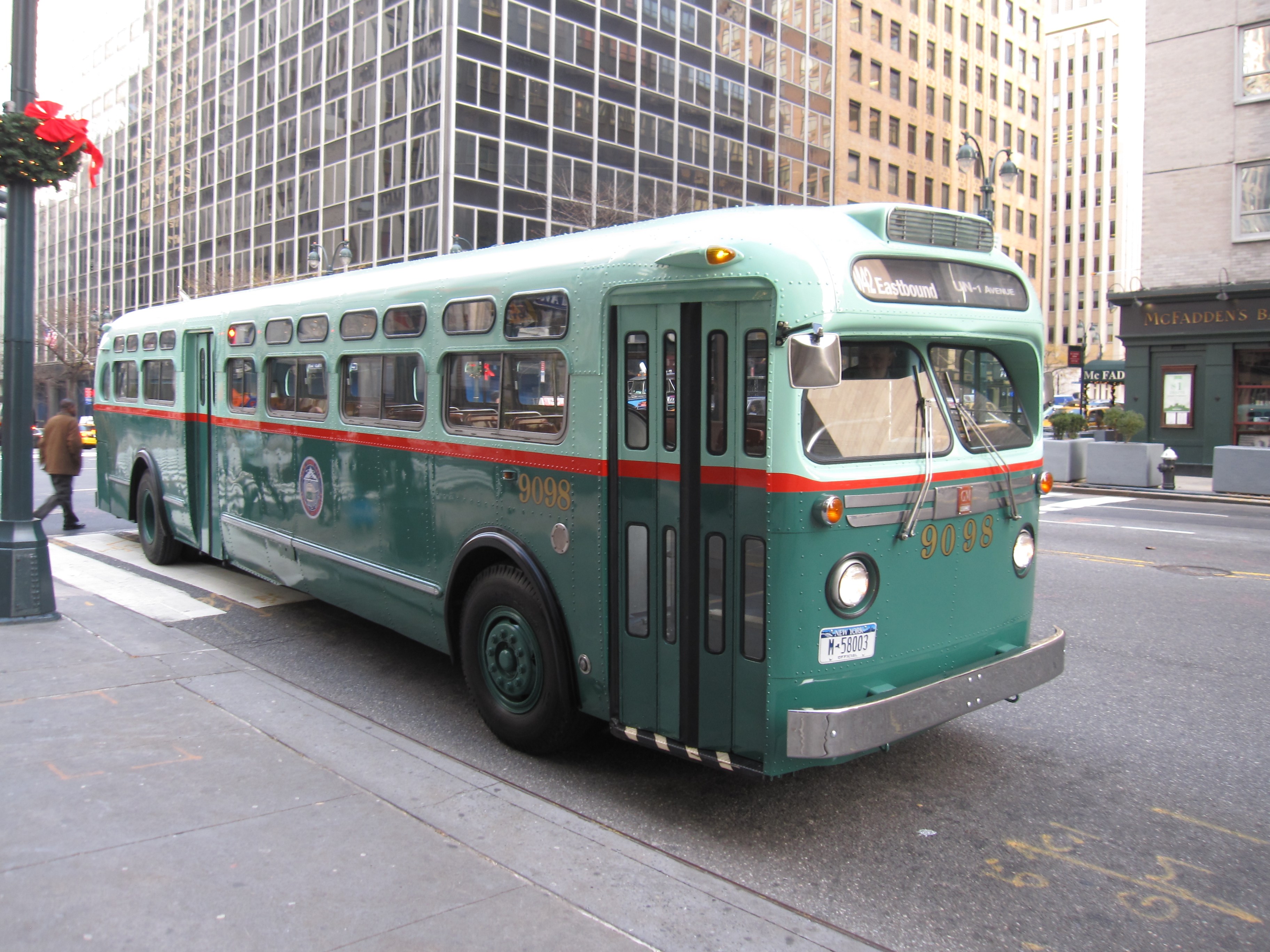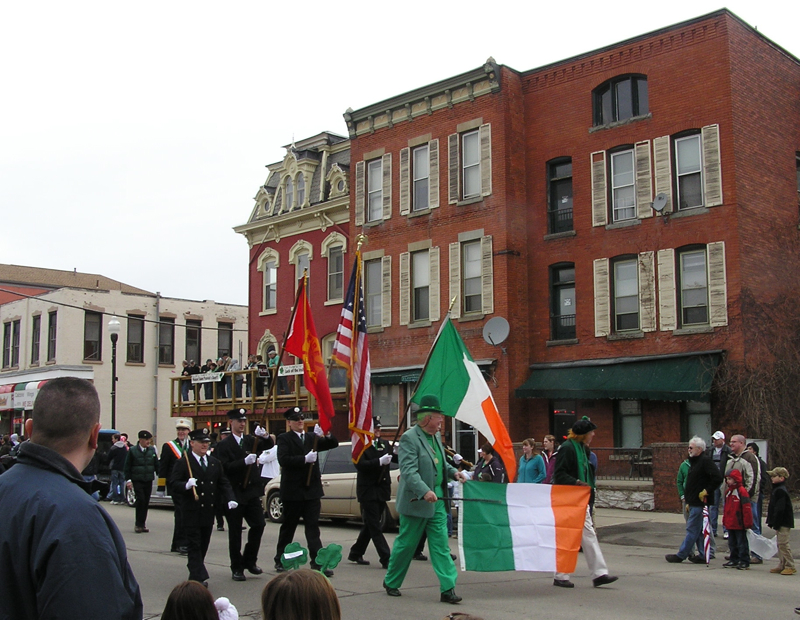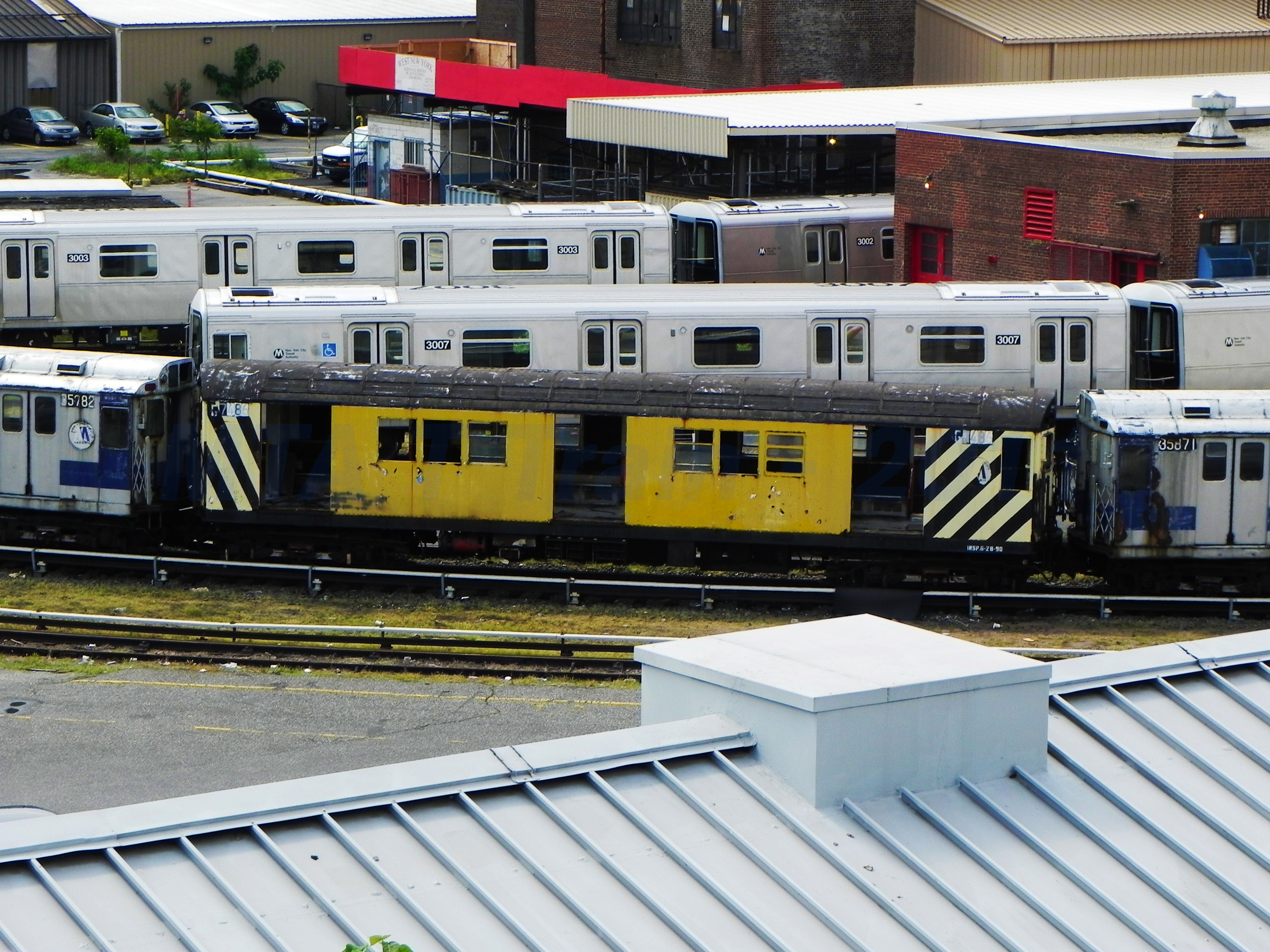|
R28 (New York City Subway Car)
The R28 was a New York City Subway car model built by American Car and Foundry (ACF) from 1960 to 1961. The cars were a "follow-up" or supplemental stock for the A Division's R26s and closely resemble them. The average car cost per R28 was $114,495. A total of 100 cars were built, arranged in married pairs. The R28s entered service in late-1960 and received air conditioning by 1982. The fleet was rebuilt by Morrison–Knudsen between 1985 and 1987. The R28s were replaced in 2001 & 2002 with the delivery of the R142 and R142A cars with the last train running on October 7, 2002. After being retired, most R28s were sunk into the ocean as artificial reefs, but four cars have survived. Description The R28s were numbered 7860–7959. They were the second order of cars to not be built with operating cabs at both ends after the R26s. They were also the last passenger cars built by ACF, with the closure of the Berwick assembly plant following the delivery of the final cars delivered in ... [...More Info...] [...Related Items...] OR: [Wikipedia] [Google] [Baidu] |
American Car And Foundry
ACF Industries, originally the American Car and Foundry Company (abbreviated as ACF), is an American manufacturer of railroad rolling stock. One of its subsidiaries was once (1925–54) a manufacturer of motor coaches and trolley coaches under the brand names of (first) ACF and (later) ACF-Brill. Today, the company is known as ACF Industries LLC and is based in St. Charles, Missouri. It is owned by investor Carl Icahn. History The American Car and Foundry Company was originally formed and incorporated in New Jersey in 1899 as a result of the merger of thirteen smaller railroad car manufacturers. The company was made up of: Later in 1899, ACF acquired the Bloomsburg Car Manufacturing Company of Bloomsburg, Pennsylvania. Orders for new freight cars were made very quickly, with several hundred cars ordered in the first year alone. Two years later, ACF acquired the Jackson and Sharp Company (founded 1863 in Wilmington, Delaware) and the Common Sense Bolster Company (of Chic ... [...More Info...] [...Related Items...] OR: [Wikipedia] [Google] [Baidu] |
R26 (New York City Subway Car)
The R26 was a New York City Subway car model built by American Car and Foundry from 1959 to 1960 for the IRT A Division. A total of 110 cars were built, arranged in married pairs. The R26s entered service on October 12, 1959, and received air conditioning by 1982. The fleet was rebuilt by Morrison–Knudsen between 1985 and 1987. The R26s were replaced in 2001 & 2002 with the delivery of the R142 and R142A cars, with the last train running on October 7, 2002. After being retired, most R26s were sunk into the ocean as artificial reefs, but two cars have survived. Description The R26s were numbered 7750–7859. They were the first cars to not be built with operating cabs at both ends. The even-numbered car carried the motor generator and battery set for electrical equipment, while the odd numbered car held air compressor for the brakes. A special version of the H2C coupler was used to link the cars, so they could easily be split if needed, and thus, they were called "semi-perman ... [...More Info...] [...Related Items...] OR: [Wikipedia] [Google] [Baidu] |
New York City Transit Authority
The New York City Transit Authority (also known as NYCTA, the TA, or simply Transit, and branded as MTA New York City Transit) is a public-benefit corporation in the U.S. state of New York that operates public transportation in New York City. Part of the Metropolitan Transportation Authority, the busiest and largest transit system in North America, the NYCTA has a daily ridership of 8million trips (over 2.5billion annually). The NYCTA operates the following systems: *New York City Subway, a rapid transit system in Manhattan, the Bronx, Brooklyn, and Queens. *Staten Island Railway, a rapid transit line on Staten Island (operated by the subsidiary Staten Island Rapid Transit Operating Authority) *New York City Bus, an extensive bus network serving all five boroughs, managed by MTA Regional Bus Operations. Name As part of establishing a common corporate identity, the Metropolitan Transportation Authority in 1994 assigned popular names to each of its subsidiaries and affiliates. T ... [...More Info...] [...Related Items...] OR: [Wikipedia] [Google] [Baidu] |
42nd Street Shuttle
The 42nd Street Shuttle is a New York City Subway shuttle train service that operates in Manhattan. The shuttle is sometimes referred to as the Grand Central/Times Square Shuttle, since these are the only two stations it serves. The shuttle runs at all times except late nights, with trains running on two tracks underneath 42nd Street between Times Square and Grand Central; for many decades, three tracks had been in service until a major renovation was begun in 2019 reducing it to two tracks. With two stations, it is the shortest regular service in the system by number of stops, running about in 90 seconds . The shuttle is used by over 100,000 passengers every day, and by up to 10,200 passengers per hour during rush hours. The 42nd Street Shuttle was constructed and operated by the Interborough Rapid Transit Company (IRT) and is currently part of the A Division of New York City Transit . The shuttle tracks opened in 1904 as part of the city's first subway. The original subway ... [...More Info...] [...Related Items...] OR: [Wikipedia] [Google] [Baidu] |
R36 (New York City Subway Car)
The R36 was a New York City Subway car model built by the St. Louis Car Company from 1963 to 1964. The cars are a "follow-up" or supplemental stock to the A Division's R33s, which some of the cars closely resemble. A total of 424 cars were built, arranged in pairs. The order includes World's Fair cars comprising 390 cars, and Main Line cars comprising 34 cars. The R36s entered service on October 24, 1963, and were overhauled in the mid-1980s. They were retired by 2003 with the delivery of the R142 and R142A cars. While most cars were reefed, some have been preserved, and others have been retained for other purposes. Description The R36s were numbered 9346–9769. They were the last entirely LAHT bodied (non-stainless steel) cars built for the New York City Subway. Cars 9346–9523 and 9558–9769 were specifically purchased for service on the IRT Flushing Line ( and trains), which was the closest line to the 1964 New York World's Fair. The cars were also referred to as ''"Wo ... [...More Info...] [...Related Items...] OR: [Wikipedia] [Google] [Baidu] |
R33S (New York City Subway Car)
The R33S (also known as R33 World's Fair or R33WF) was a New York City Subway car that was built by St. Louis Car Company in 1963 for the IRT A Division. They were purchased for service on the IRT Flushing Line ( 7 and trains), which was the closest line to the 1964 New York World's Fair. A total of 40 cars were built, arranged as single cars. While in regular service, each R33S was coupled to five two-car consists of R36 cars to make 11-car trains for the 7 and routes. The R33S fleet entered service on September 26, 1963, and was originally painted in a light blue turquoise "Bluebird" scheme. The fleet was overhauled in the mid-1980s, during which the cars were painted red, leading to the nickname " Redbirds". The R33S fleet was replaced in the early 2000s with the delivery of the R142 and R142A cars, with the last train of R33S and R36s running on November 3, 2003. After being retired, some R33S cars were preserved, but most were kept for work service; many of the work ... [...More Info...] [...Related Items...] OR: [Wikipedia] [Google] [Baidu] |
Westinghouse Electric (1886)
The Westinghouse Electric Corporation was an American manufacturing company founded in 1886 by George Westinghouse. It was originally named "Westinghouse Electric & Manufacturing Company" and was renamed "Westinghouse Electric Corporation" in 1945. The company acquired the CBS television network in 1995 and was renamed "CBS Corporation" until being acquired by Viacom in 1999, a merger completed in April 2000. The CBS Corporation name was later reused for one of the two companies resulting from the split of Viacom in 2006. The Westinghouse trademarks are owned by Westinghouse Electric Corporation, and were previously part of Westinghouse Licensing Corporation. The nuclear power business, Westinghouse Electric Company, was spun off from the Westinghouse Electric Corporation in 1999. History Westinghouse Electric was founded by George Westinghouse in Pittsburgh, Pennsylvania, on January 8, 1886. The firm became active in developing electric infrastructure throughout the U ... [...More Info...] [...Related Items...] OR: [Wikipedia] [Google] [Baidu] |
General Electric
General Electric Company (GE) is an American multinational conglomerate founded in 1892, and incorporated in New York state and headquartered in Boston. The company operated in sectors including healthcare, aviation, power, renewable energy, digital industry, additive manufacturing and venture capital and finance, but has since divested from several areas, now primarily consisting of the first four segments. In 2020, GE ranked among the Fortune 500 as the 33rd largest firm in the United States by gross revenue. In 2011, GE ranked among the Fortune 20 as the 14th most profitable company, but later very severely underperformed the market (by about 75%) as its profitability collapsed. Two employees of GE – Irving Langmuir (1932) and Ivar Giaever (1973) – have been awarded the Nobel Prize. On November 9, 2021, the company announced it would divide itself into three investment-grade public companies. On July 18, 2022, GE unveiled the brand names of the companies it will ... [...More Info...] [...Related Items...] OR: [Wikipedia] [Google] [Baidu] |
Hornell, New York
Hornell is a Administrative divisions of New York#City, city in Steuben County, New York, Steuben County, New York (state), New York, United States. The population was 8,259 at the 2020 census. The city is named after the Hornell family, early settlers. The City of Hornell is surrounded by Hornellsville, New York, Town of Hornellsville. Hornell is about south of Rochester, Monroe County, New York, Rochester and is near the western edge of Steuben County. Hornell is nicknamed the "Maple City" after the large maple trees that once grew throughout the town and covered the surrounding hills of the Canisteo Valley. Hornell has the largest Saint Patrick's Day parade and celebration in the area, bringing many out to welcome spring and show their green. History What is now Hornell was first settled in 1790 under the name "Upper Canisteo", to distinguish it from the community of Canisteo (village), New York, Canisteo, then known as "Lower Canisteo". The family of Benjamin Crosby wer ... [...More Info...] [...Related Items...] OR: [Wikipedia] [Google] [Baidu] |
Graffiti
Graffiti (plural; singular ''graffiti'' or ''graffito'', the latter rarely used except in archeology) is art that is written, painted or drawn on a wall or other surface, usually without permission and within public view. Graffiti ranges from simple written words to elaborate wall paintings, and has existed Graffito (archaeology), since ancient times, with examples dating back to ancient Egypt, ancient Greece, and the Roman Empire. Graffiti is a controversial subject. In most countries, marking or painting property without permission is considered by property owners and civic authorities as defacement and vandalism, which is a punishable crime, citing the use of graffiti by street gangs to mark territory or to serve as an indicator of gang-related activities. Graffiti has become visualized as a growing urban "problem" for many cities in industrialized nations, spreading from the New York City Subway nomenclature, New York City subway system and Philadelphia in the early 1970s to ... [...More Info...] [...Related Items...] OR: [Wikipedia] [Google] [Baidu] |
R22 (New York City Subway Car)
The R22 was a New York City Subway car built by the St. Louis Car Company from 1957 to 1958. The cars were a "follow-up" or supplemental stock for the A Division's R21s and closely resemble them. A total of 450 cars were built, arranged as single units. Two versions were manufactured: Westinghouse (WH)-powered cars and General Electric (GE)-powered cars. The first R22s entered service on April 13, 1957. Several cars in the fleet were retrofitted as part of an automated-signaling test on the 42nd Street Shuttle in 1962 and were destroyed in a 1964 fire. The R22s were replaced by the R62As in the 1980s, and the final train of R22s ran on December 30, 1987. Several R22 cars were preserved, though the majority were scrapped. Description The R22s were numbered 7300–7749. They were the last single cars built prior to the R33S cars built in 1963. The fleet had two-paned storm door windows that could be opened by dropping down the upper window, though cars 7515–7524 had single ... [...More Info...] [...Related Items...] OR: [Wikipedia] [Google] [Baidu] |
R21 (New York City Subway Car)
The R21 was a New York City Subway car built by St. Louis Car Company from 1956 to 1957 for the IRT A Division. A total of 250 cars were built, arranged as single units. Two versions were manufactured: Westinghouse (WH)-powered cars and General Electric (GE)-powered cars. The first R21s entered service on November 7, 1956. The R21s were replaced by the R62As in the 1980s, and the final train of R21s ran on December 30, 1987. Four R21 cars were preserved, while the rest were scrapped. Description The R21s were numbered 7050–7299. They were similar to the R17s, except that they featured windows of a slightly different design. The cab doors were mounted the same way as the newer R62 and R62A subway cars; however, this was not repeated on the next order for R22 subway cars, which reverted to the normally mounted cab doors. There were two versions of the R21: Westinghouse Electric-powered cars (7050–7174) and General Electric-powered cars (7175–7299). History T ... [...More Info...] [...Related Items...] OR: [Wikipedia] [Google] [Baidu] |






.jpg)